Recent Posts
Practice Fire and Carbon Monoxide (CO) Safety During Cold Weather
12/13/2023 (Permalink)
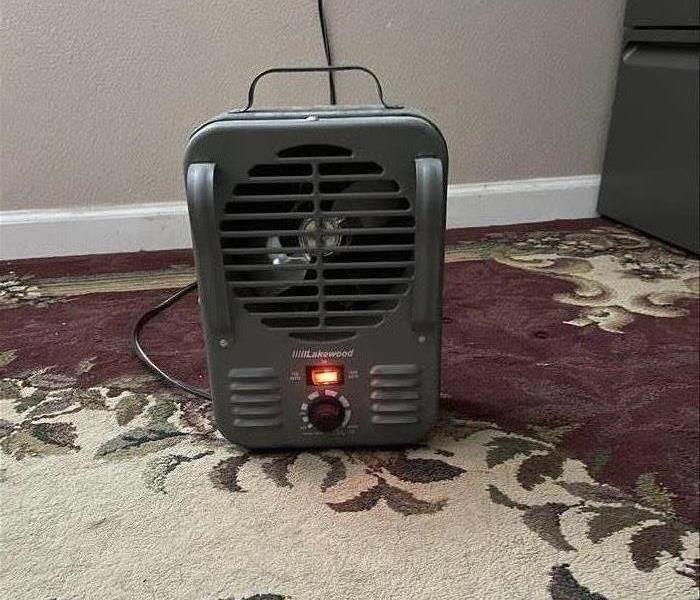 A grey space heater in an office type setting. The space heater is sitting in a safe distance away from all objects that could catch on fire.
A grey space heater in an office type setting. The space heater is sitting in a safe distance away from all objects that could catch on fire.
Winter is soon to come, and with winter it brings wind, snow, and freezing temperatures. When it’s really cold outside some offices and homes are just not as warm as you would like them. Instead of turning up the furnace, many people choose to add a space heater.
If, for some reason, your electricity goes out and you need to use a generator, you need to know all the safety measures when using one.
When using a space heater or a generator, there is more to it than just plugging it in and walking away. You need to understand all the safety precautions, such as how to prevent fires, carbon monoxide poisoning, and so much more. Here are just a few tips on what to do and not to do.
Space Heaters:
Keep combustibles at least three feet away
Use a wall outlet and never a power strip
DO NOT leave running unattended or for prolonged periods in a confined space to reduce hyperthermia hazards
Generators:
Use portable generators outside only, at least 20 feet from the home, and direct the exhaust away from the home and any other buildings.
Never use a generator inside a home, basement, shed, or garage, even with the door open.
Smoke and CO Alarms:
Install smoke alarms on every level of the home and inside each bedroom
CO alarms should be placed on every level of the home and outside sleeping areas
Test the alarms every month to make sure they are working
Dryer Duct Cleaning
12/6/2023 (Permalink)
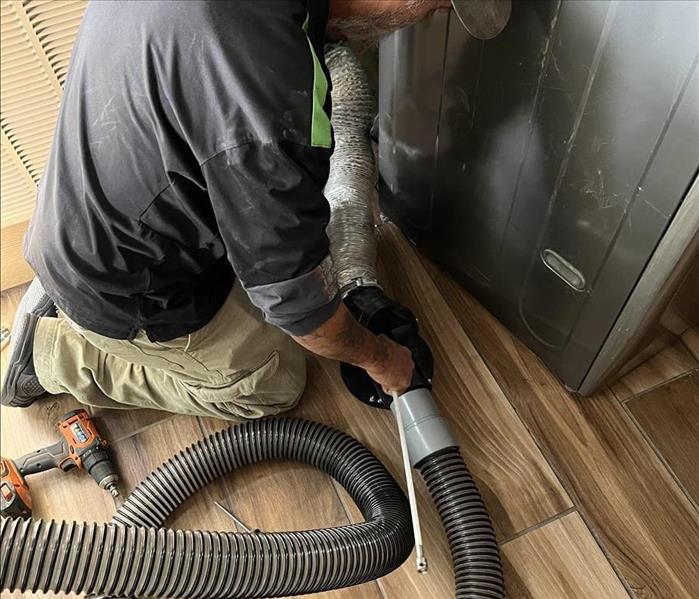 A SERVPRO of Casper employee cleaning a customers dryer vent.
A SERVPRO of Casper employee cleaning a customers dryer vent.
While having ducts cleaned in homes and businesses has been a common service nationally for decades, it has only recently gained widespread awareness in Wyoming. The fact that property owners are realizing the importance of cleaning built-up dust and debris from their duct systems is helpful to maintaining healthy indoor environments. But one vent that is still often forgotten is the dryer duct vent.
Every time you do a new load of laundry in your dryer, you instinctively clean out the lint trap. This is a good practice. It helps your machine work more efficiently, and also helps prevent safety hazards. But it is only the first step in controlling dryer lint buildup. The duct that runs from the dryer to the outside of the building helps remove the hot air and moisture. Lint slowly builds up in this duct over time. When there is a heavy build up in in the dryer duct, it reduces the airflow, and exhaust gases start backing up, coupling with the high temperature. It is a recipe for a dangerous fire. The US Fire Administration states that 34% of residential fires are due to dirty dryer vents. On gas-fired dryers, there can also be a risk of carbon monoxide buildup in the home, if the dryer cannot properly discharge its exhaust. This can create an air quality hazard for you and your family.
These are excellent reasons to have your dryer duct cleaned regularly. In addition to making for a safer home, keeping your dryer ducts clean allows proper air flow for your dryer. This results in shorter drying times, lower energy bills, fewer repairs, and potentially longer dryer life.
NADCA (National Air Duct Cleaners Association) recommends that dryer vents get cleaned at least once a year.
Tips for Frozen Pipes
11/7/2023 (Permalink)
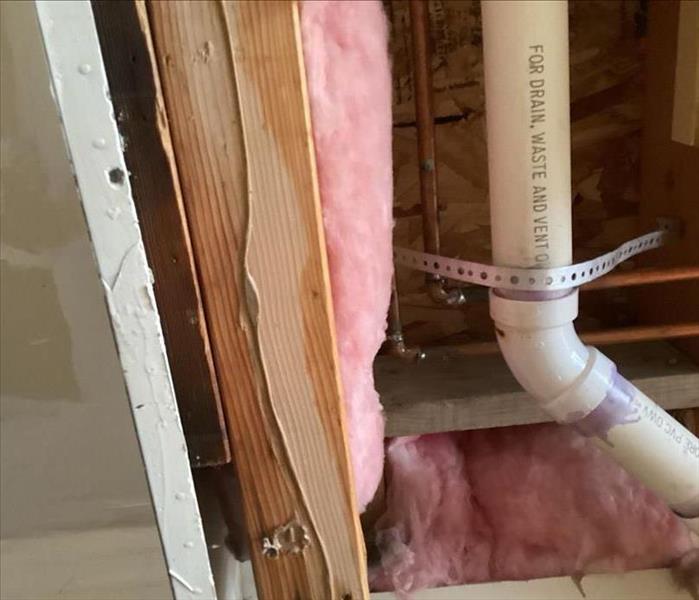 A split from a frozen Pipe
A split from a frozen Pipe
If a person thinks about the many aspects of water, it is really fascinating. How something that is so essential for your life can also be deadly. Water can also cause major damage in homes. Anywhere there is a water source, there is the potential to have problems in the home, particularly in the winter. With us living in Wyoming, there is always a risk of frozen and broken pipes. When water freezes it expands, and it puts tremendous pressure on the pipes which can cause them to break. Preparing your property to withstand cold temperatures can prevent many pipe breaks. Unfortunately, extreme weather conditions can exceed the capabilities of freeze protection. If temperatures are subzero and the wind is blowing, there could be weak spots where the cold air can reach the pipes. Pipes that freeze most frequently are ones with direct exposure to severe temperatures such as hose bibs and sprinkler lines. Pipes in unheated interior areas such as basements, crawl spaces, attics, garages, or kitchen cabinets are also susceptible. And pipes that run against an outside wall that has little or no insulation may freeze through conduction. It is still highly recommended to take reasonable precautions to prevent frozen pipes. If there are water supply lines in the garage, it is best to keep the garage doors closed as much as possible. In subzero temperatures, open cabinets to kitchen and bathroom sinks so the warm air can circulate around the plumbing. It can also help to leave the faucet on a little, and allow a trickle of cold water to flow. Its best to make sure that the thermostat is between 68F-70F at least until the temperatures get out of the subzero range. If the property going to be vacant, make sure the thermostat is no lower than 55F. It is a good idea to have someone check in on the property regularly to make sure there are no problems that arise.If your pipes happen to freeze, you can apply heat to the section of pipe using an electric heating pad wrapped around the pipe, a hair dryer, or a space heater (Keep away from flammable materials). Do not use a gas torch, kerosene or propane heater, charcoal stove, or anything with an open flame.If there is water damage in your home due to a broken pipe, please don’t hesitate to reach out to SERVPRO of Casper. We are here for you 24/7, 365 Days a year.
Ice Dams Prevention
9/9/2022 (Permalink)
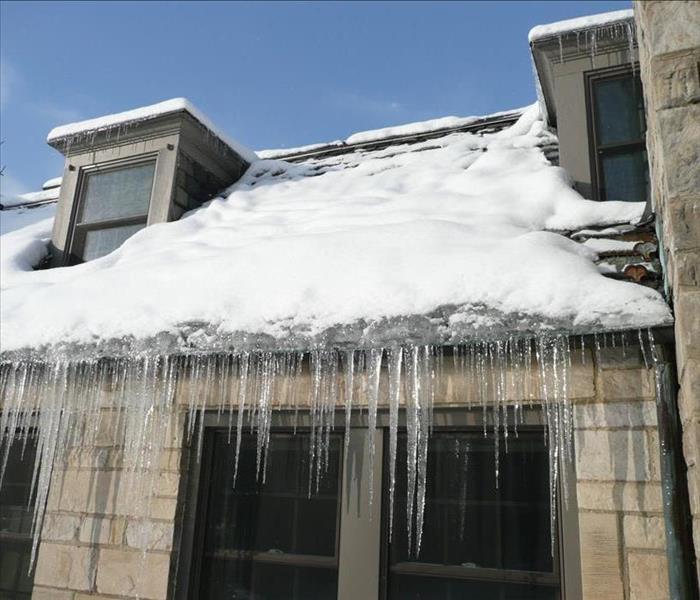 A house that has been affected by an ice dam.
A house that has been affected by an ice dam.
Ice dams occur when heavy snow buildup melts during the day, and then refreezes at night when temperatures drop.
After several days of melting-freezing cycles, the melted water and ice will work up under the shingles. The water will enter the attic and eventually cause damage to the ceilings, wall and contents. In some cases the ice dam could go unnoticed for an extended period of time, and it could cause significant damage to the building and its contents.
You can take steps to reduce the chance of an ice dam forming on your property:
- Thoroughly clean all leaves, sticks and other debris from your home's gutters and down spouts. By doing this it allows melting snow to flow through the gutters and down the spouts.
- If possible, and if it is safe to do so, try to keep the snow on your roof to a minimum. Try using long-handled devices on the market, often called "roof rakes". This will let you pull the snow off the roof from the ground. Keeping the heavy snow off your roof will help reduce the chance for both an ice dam formation and roof failure.
- All winter long, try keeping gutters and down spouts clear of snow and icicles.
- Evaluate the insulation and ventilation in your attic. Good airflow from under the eaves or soffit, along the underside of the roof and out through the roof vents are critical. The insulation is important, as it helps prevents heat loss from the interior of the home. The venting allows the attic air to stay cold enough to prevent or minimize the freeze/thaw. Consult a reputable roofing and/or insulation contractor about these improvements.
Benefits of Duct Cleaning
9/9/2022 (Permalink)
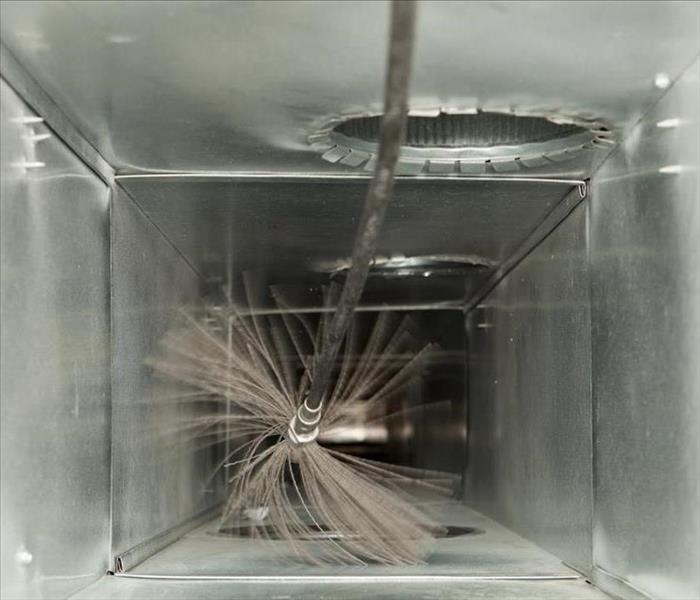 A brush running through cleaning the duct.
A brush running through cleaning the duct.
If you’re like most people, it’s been a long time since you have had your ducts cleaned. And in some cases your ducts may have never been cleaned at all! Duct cleaning isn’t something that many homeowners think about. It is rare that the ducts in a home are inspected regularly, or are routinely cleaned. The National Air Duct Cleaners Association (NADCA) recommends you have your ducts cleaned every 3-5 years. SERVPRO of Casper has many years of duct cleaning experience, and have cleaned hundreds of duct systems.
The Benefits of Duct Cleaning
- You can reduce strain on your system. Over time, your air ducts accrue dust, dirt, and other contaminants, which can disrupt the airflow. So your HVAC system has to work harder, it can result in higher energy bills and possible operational issues.
- Improve air quality. A professional duct cleaning removes pet and human dander, fur, debris, and more from your system. By cleaning the system, it helps prevent the redistribution of dust and fine debris throughout your home.
- Reduce or eliminate odors. Sometimes odors linger throughout your home no matter how much you clean. In some cases, the problem could be from your duct system. If you have this issue, a duct cleaning can either reduce or eliminate the problem.
If you are interested in getting your ducts cleaned, SERVPRO of Casper offers FREE estimates. Call us anytime at 307-235-6558.
How To Stop A Tankless Toilet From Flushing Constantly
9/6/2022 (Permalink)
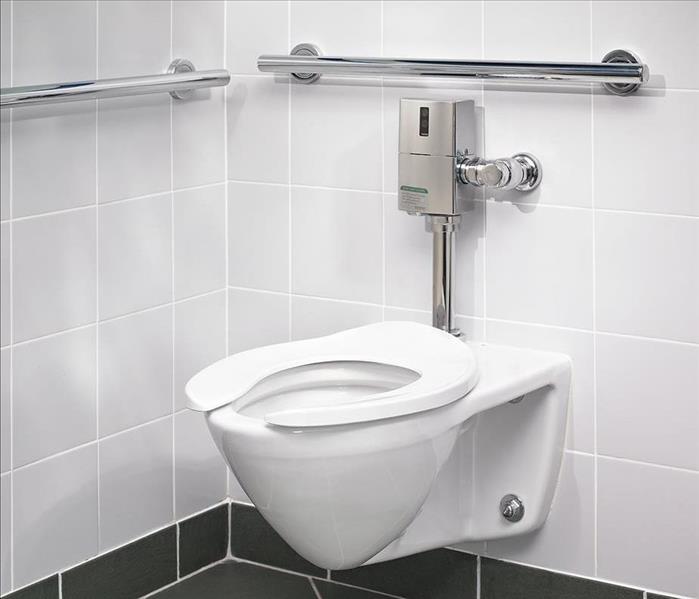 Commercial Tankless Toilet
Commercial Tankless Toilet
If your commercial tankless toilet is continuously flushing, there may be a problem with the flushometer. The flushometer is the mechanism that flushes the toilet. If the flushing does not stop, the toilet may overflow and that could result in damages.
First Step:
If the toilet won't stop flushing, try these steps first:
Turn Off Water to Access the Gasket:
To access the gasket, you should first turn off the water. You will then need to remove the cover on the flushometer. You will first need to unscrew the cover on the side of the flushometer and then use a wrench to remove the lid on top. This will expose the gasket, allowing you to remove and clean it.
Clean the Gasket:
The gaskets in flushometers can become covered with sediment due to their constant exposure to water. You should carefully clean the gasket. This includes using a small instrument, such as a needle, to clean out the weep hole. Doing this will improve the vacuum created by the gasket and hopefully stop the continuous flushing.
Reinstall and Test
After cleaning the gasket, you should put it back in its place and reattach the cover. Then turn the water back on and flush the toilet. If the flushing continues, you may have to replace the gasket or call a plumber.
If cleaning or replacing the gasket does not work, call your local plumber so your toilet does not cause a water damage on your property. If a water damage should occur call SERVPRO of Casper for your restoration needs at 307-235-6558.
Different Types of Water Extraction Pumps
8/24/2022 (Permalink)
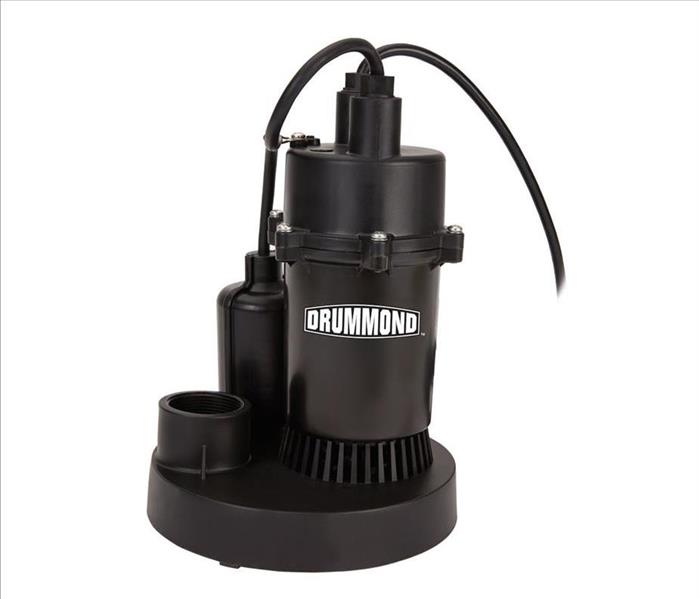 Sump pump
Sump pump
Three Different Types of Pumps That Can Remove Large Amounts of Water
There are several equipment options for extracting water. There are differences between a sump pump, trash sump pump, and truck-mounted pumps. The following details can help determine which of these three pump designs is the best choice for a particular water damage scenario.
1. Sump Pump
A submersible industrial pump is a portable solution for removing water. These pumps draw water at a much faster rate than a truck-mounted pump. Sump pumps can be ideal for crawlspaces, and basements with standing water of two inches or more.
2. Trash Pump
Trash pumps are great for pumping up water in crawlspaces that have a lot of mud or debris. A strainer on the end of the pump ensures that this equipment does not suck up debris that is much larger than leaves or twigs.
3. Truck-Mounted Pump
A diesel truck mount is another solution for extracting standing water. This truck relies on industrial hoses to suck up water from any flooded location. They will have a black water tank on board that will transport this water to an appropriate disposal area. These pumps are most commonly used for any type of standing water that is less than two inches deep.
If you run into any type of flooding problems give SERVPRO of Casper a call. We have all the right pumps to get the water out of your home or building.
Wildfire Preparation
8/2/2022 (Permalink)
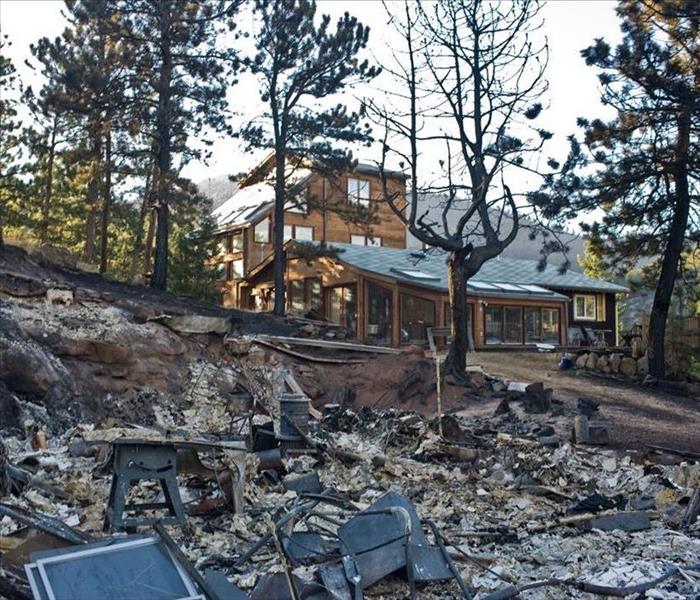 Some burnt materials, and a house that was saved by following the safety guidelines.
Some burnt materials, and a house that was saved by following the safety guidelines.
In Wyoming, our lack of summertime rain makes for very dry conditions. When the grass and weeds get dry enough, it takes very little to ignite a wildfire. It could be a cigarette that is thrown out the window, chains from trailers dragging and sparking, an unmanned fire from a camp fire, or a bolt of lightning. Any one of the these scenarios can set a wildfire, and when it’s dry, it is hard to get the fire under control.
There are a few things that can be done to help save properties from a wildfire.
Within 30 Feet -
- Clear combustible materials like pine needles, branches, and dead leaves.
- Cut down any tree limbs that are at least 15 feet from the ground. This will help prevent the spread to your property line.
- Keep any kind of vegetation off your building.
- Place flammable lawn furniture in storage when not in use.
- Use gravel instead of wood chips. Try to avoid using flammable décor.
Within 30-100 Feet -
- Cover pathways or driveways with gravel or rock. They are good materials for a “fuel break”. You want fuel breaks on your property, as they will help stop the spread of the fire.
- Cut branches that are 8 feet or closer to the ground
- Get rid of combustible vegetation
Within 100-200 Feet -
- This is where if you can store firewood or scrap wood.
- Still clear combustible vegetation
- When planting trees, keep them far apart so the branches don’t touch.
If you run into a situation that you have a fire or smoke damage from a wildfire, call SERVPRO of Casper. We will provide a free walk-through assessment on your house.
Hotel Water Damage
8/2/2022 (Permalink)
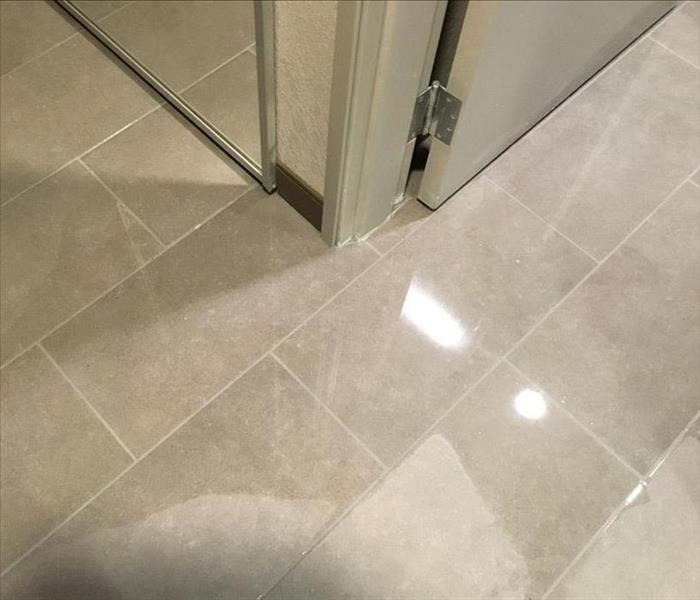 Bathroom, and hall floor with standing water.
Bathroom, and hall floor with standing water.
We received a call from a local hotel around 8:00 at night to respond to a water damage emergency. The hotel had checked a guest into a room on the 4th floor. The guest overflowed the bathtub, and it ran down all four floors. To make matters worse, the hotel had recently completed extensive renovations on two of the floors. We were asked to extract the standing water, and use equipment to stabilize the situation for the night. Our crew arrived quickly, removed the excess water, and placed dehumidifiers in the affected areas.
The next day, the hotel authorized complete water damage services. Our crew returned, did more water extraction, pulled vinyl baseboard, and placed air movers. We were able to get all the affected areas dry in 4-5 days. Because this hotel contacted us right away, we were able to save more materials, they got their rooms back quickly, and their customers got a good night’s sleep.
If you have a water damage, call SERVPRO of Casper right away. The longer it soaks, the more extensive the damage can become.
Tornado Safety
7/1/2022 (Permalink)
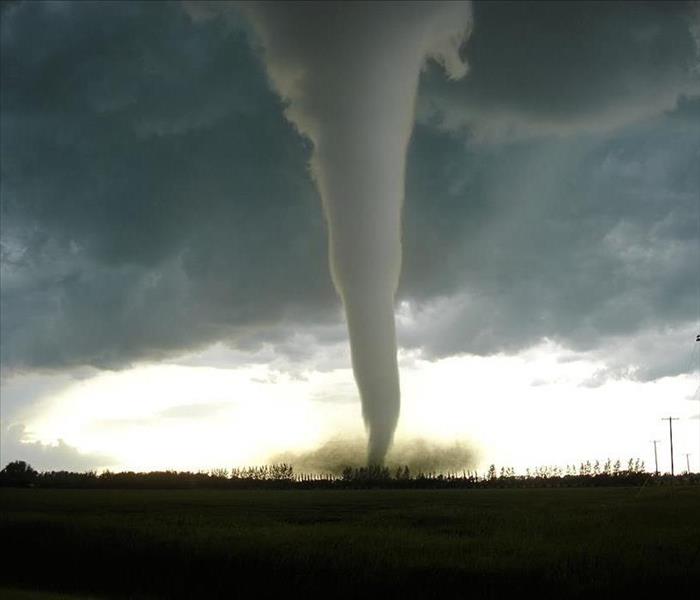 Tornado destruction
Tornado destruction
Tornadoes are not all that common in this part of the state, but they do exist. When a tornado strikes in Wyoming, it is usually in an open space like a field. However, they have touched down in towns before. In the unlikely event of a tornado occurrence near you, here is what to do if you are in a mobile home versus a traditional home:
Traditional Home:
Have a radio for weather alerts and updates nearby, and make sure you have fresh batteries on hand.
Get to the lowest level of your home, such as a basement or storm cellar. If you don't have a basement, go to an inner hallway or a closet, or the bathtub in a bathroom.
Stay away from all windows and glass doorways.
Cover your head and eyes with a blanket or jacket to protect against flying debris and broken glass.
Use stairs only. Do not use an elevator because the power may fail, leaving you trapped inside.
Keep pets on a leash or in a crate close by.
Before going outside, be certain the storm has passed.
Stay in the building you are in. Attempting to out run a tornado to get to a different location is dangerous.
Mobile home:
Mobile homes are not safe during a tornado. You need to evacuate. Even mobile homes equipped with tie-down systems cannot withstand the force of a tornado's winds.
Listen to all local watches and warnings, and take them seriously. If need to, try to get into the basement of a near by home or building.
If no shelter is immediately available, find the lowest-lying area near you and lie flat down in it, covering your head with your hands. Do NOT try to outrun the tornado.




 24/7 Emergency Service
24/7 Emergency Service








